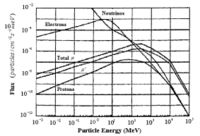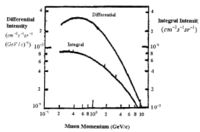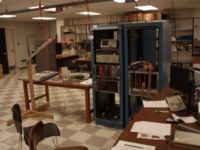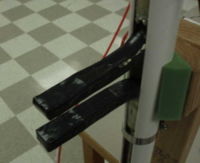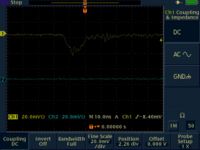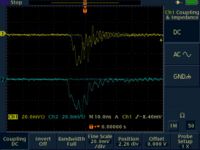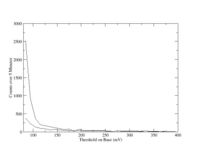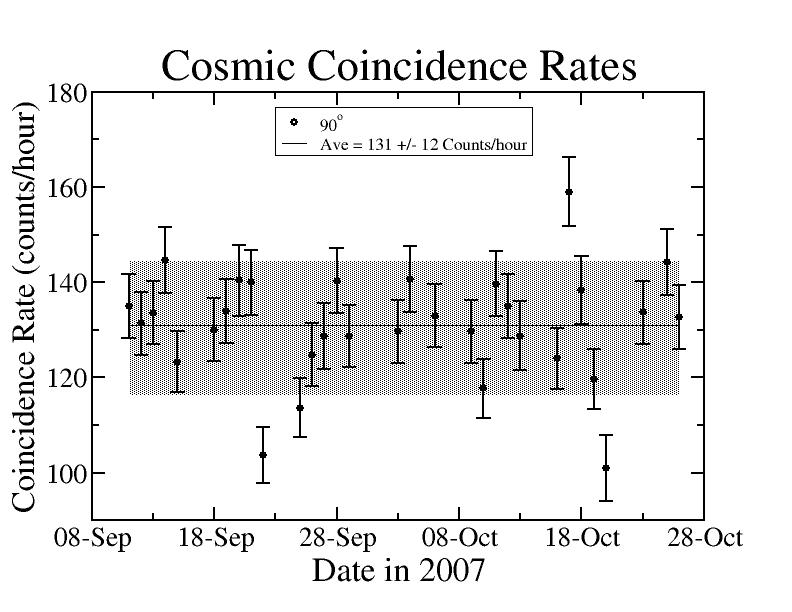Cosmics for High School Teachers
The following is intended for an audience of High school teachers and their students.
What is a Cosmic Ray
Cosmic rays are particles originating outside the earth which hit the Earth's atmosphere. Cosmic rays are made up of all the elements in the periodic table. 89% of the particles are protons, 10% are alpha particles (a helium atom without its electrons), and 1% are heavier elements.
Galactic and Solar
The term cosmic rays usually refers to Galactic cosmic rays that are further divided into two categories; either galactic or extragalactic. Galactic cosmic rays are all particles which enter our solar system from outside. Extragalactic cosmic rays flow into our galaxy having energies beyond 10e15 eV (amount of energy your body creates in 1/1000 of a second). They are very rare with only 1 entering a square meter on the earth's surface per year.
Solar cosmic rays originate from the sun and have energies between 10 to 100 kilo-electron volts (keV = 1.6 e-16 Joules = amount of heat your body produces in 1e-18 seconds [1/1000 femto-seconds]).
Primary and Secondary cosmic rays
Primary cosmic rays are galactic cosmic rays which can interact with stellar matter and the Earth's atmosphere. The interaction of the primary cosmic rays with the Earth's atmosphere produce secondary cosmic rays. The secondary particles produced are pions, muons, gamma rays, neutrinos, and neutrons.
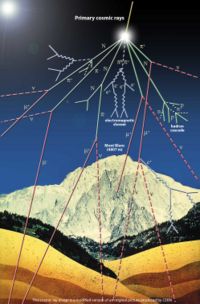
The flux of cosmic ray particles as a function of their energy. The flux for the lowest energies (yellow zone) are mainly attributed to solar cosmic rays, intermediate energies (blue) to galactic cosmic rays, and highest energies (purple) to extragalactic cosmic rays.( S. Swordy, The energy spectra and anisotropies of cosmic rays, 2001, Space Science Reviews 99, pp85–94)
At sea level, cosmic rays are mostly composed of MeV energy electrons and 100 MeV energy muons. The proton flux is more than 10,000 times smaller than the electron flux.(J. Ziegle, NIM, vol 191, (1981), 419
The more energetic muons are the most penetrating through buildings and are the dominant signal source for nuclear physics labs which tend to be underground or in basements of buildings.
Oh-My-God- Cosmic rays
About 15 cosmic rays having an energy of eV have been seen by two groups, the AGASA detector in Japan and University of Utah's Fly's Eye Cosmic Ray Detector. ( the first publication Physical Review Letters, 22 November 1993, http://arxiv.org/abs/astro-ph/9410069). Particles of this energy could light up a 40 Watt light bulb for a whole second. In 2003, the AGASA group reported seeing 11 cosmic ray events with energies in the 10^{20} eV range. In 2004, 2 cosmsic rays having an energy of eV and 10 having an energy of eV were reported by the group in Phys. Rev. Letter.
At a January 12, 2005 conference of the American Astronomical Society, particle physicist Glennys Farrar presented a paper tracing five similar very-high-energy cosmic rays, all of which were detected between 1993 and 2003, to a pair of colliding galaxy clusters 450 million light-years from Earth. Farrar speculated that the clusters' powerful magnetic fields could become warped in the collision, accelerating charged particles to the extreme energies astronomers have observed.
In June 20,2006, the NSF provided $2.4 million to upgrade the "telescope" by relocating it to a larger area and install more scintillators designed to improve is cosmic ray detection sensitivity an order of magnitude. The "telescope" will be composed of a ground array of 564 table-shaped scintillation detectors, each about 3 feet tall and 6-by-10-feet wide. The scintillation detectors will be spread in a grid over an 18-mile-by-22-mile area west of Delta. The BLM right-of-way grant/temporary use permit will allow scientists to build the central laser facility and install 460 of the scintillation detectors on BLM land, which covers 80 percent of the observatory site.
[edit]
How are Cosmic Rays created
It is currently believed that Galactic cosmic rays are the result of supernova explosions which happen about once every 50 years in our galaxy. Galactic cosmic rays spend about 10 million years roaming the galaxy due to the magnetic fields of stellar objects before they leave the galazy into intergallactic space becoming extragalactic cosmic rays for planets outside our galaxy.
How do we detect cosmic rays
scintillators
Scintillators are plastic rectangular paddles which have been polished improve the transmission of light out of the plastic. Five of the 6 sides are covered with a reflective material (aluminized mylar) which reflects light back into the plastic material in order to direct the light out of the 6th side with has a detector capably of measuring light (Photo-Multiplier Tube, PMT).
Within the plastic scintillator we would like the light to propagate in time scales which are a lot smaller than the mean time between atomic collisions. The mean time between collisions in a solid is about seconds. Unfortunately an atam takes about seconds to de-excite. This means that an atom will have at least 10 opportunities to release energy by collission before is has a chance to release energy by giving off light. Doping the plastic with material composed of Benzene rings is the means by which the plastic becomes transparent to the propagation of light. The Bezene ring has the nice feature that the electrons in the material are not localized to the atom. The "Pi" orbitals of the electrons in the material do not notice the atomic collsions. A charged particle will excite the electrons in the Benzene ring to a higher orbit (S1).
Another nice feature of the Benzene ring is the existence of vibrational states in the ground state. When the electron in the Benzene ring de-excite by emitting a photon it has several ground states to choose from due to the vibrational splitting of the ground state. As a result the emitted photon is less likely to have the energy needed to excite or ionize the next Benzene atom it encounters. This makes the plastic transparent to the the photon.
Apparatus
The Cosmic Telescope consists of two Scintillators with PMTs connected to them. These Scintillators are separated by 2cm and mounted in a long piece of PVC pipe. This pipe is connected to a sturdy base of wood and is able tilt in order to measure angular distributions. High Voltage Units are plugged into each Scintillator.
First Cosmic ray scope pictures using PMT + Scintillator
First scope picture on a single detector
now look for a coincidence signal between two PMT detectors
To discriminate between noise and a signal, the output of each scintillator is sent to a Quad Discriminator. The discriminator threshold is changed until the cosmic particle flux (rate) becomes independent of the threshold. If the threshold is too low the rate will be high and change abruptly with the noise on the threshold. If the threshold is too high you have an cosmic energy cut which is far above the detector noise. The mere existence of a threshold causes you to iinvoke a cut on the energy of the cosmic ray. Bu the noise of the detector also places a low energy limit on the cosmic ray you can detect. Below you see the count rate from each PMT as a function of the discriminator threshold setting. The rate appears to be constant after about 225 mV for both PMTs. If you change the HV on any tube you will need to do this again.
This is where the threshold of 225mV is kept constant. From this unit the top scintillator is plugged into a Singles Counter. Also, both scintillators run from the discriminator to a Logic Unit. The logic unit looks for the coincidences and when one is found, a signal is sent into a Constant Franction Disc. This unit makes the signal readable for the Coincidence Counter.
Cosmic rates measured each hour when the telecope accepts cosmics which intersect the earth's surface perpendicularly (defined as zero degrees).
| Time Start | Time Stop | Time elapsed (hour) | Singles Count (on top) | Coinc. Counts | Coinc. per hour | ||
| 1:20 pm | 2:20 pm | 1 | 7521 | 133 | 133 | 11.53 | 1.67 |
| 2:20 pm | 3:20 pm | 1 | 14249 | 112 | 112 | 10.58 | 19.33 |
| 3:20 pm | 4:20 pm | 1 | 20381 | 149 | 149 | 12.21 | 17.67 |
Here is what the rate looks like after 2 months of data taking.
